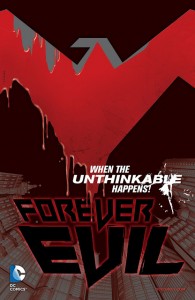 Finally, after wading through a prelude disguised as an event (known as Trinity War), we get the main course. Forever Evil promises big – the main heroes of the DC universe are missing, presumed dead, and the newly emerged Crime Syndicate have taken their place, turning Earth into a haven for villains. But (as the marketing material is keen to remind us) evil is relative, setting the stage for something truly special – villain on villain action. And I could not be more happier.
Finally, after wading through a prelude disguised as an event (known as Trinity War), we get the main course. Forever Evil promises big – the main heroes of the DC universe are missing, presumed dead, and the newly emerged Crime Syndicate have taken their place, turning Earth into a haven for villains. But (as the marketing material is keen to remind us) evil is relative, setting the stage for something truly special – villain on villain action. And I could not be more happier.
The series is told from Lex Luthor’s perspective, and while he may be the protagonist, he is definitely far from sympathetic. Geoff Johns toes the line here – making Luthor endearing without turning him into a hero is not a simple task but, again, speaking relatively, he may as well be a saint in this event, and Johns handles Luthor’s new position admirably.
The many other villains of the DCU make appearances throughout the issue, and while the Bat-family gets the most time to shine, we still manage to get time with others, foreshadowing character allegiances. Included is a twist you may recall was used in Marvel’s own event Civil War, but if done right can really mix things up for the DC universe hero community.
There’s something to be said about some good old fashioned villains being evil. Johns, at least initially, really nails the whole vibe of the Crime Syndicate – these guys are pure, kryptonite snorting evil. This is the rare case where over the top is the only thing that would work in this case, and based on the first issue alone, these guys ratchet it up to eleven. That being said, they seem to be pushed to the side this issue, not giving us a whole lot of time with this group, leaving their reasoning behind, and not addressing some of the major cliff-hangers from Trinity War that possibly should be answered, but these gripes are minor if this characterisation continues this way.
Following on from this, Finch’s design of the characters is truly memorable. Each of the Syndicate members has a Justice League parallel, giving the team a sense of familiarity, while deviating from the source enough to be suitably villainous. The standout here is Ultraman, Superman’s parallel, who Finch draws subtly enough that at first glace he looks like the Man of Steel, but upon closer inspection has just enough wrong with him to know somethings up.
Outside of the characters, this issue is filled with Finch’s usual rough art style, and it completely works. A world steeped in evil lends itself well to his art style, and he imbues an impressive amount of detail to each and every panel. This is Finch drawing at the top of his game.
Forever Evil #1 sets up something quite delicious, and while it remains to be seen whether this issue is an indication of where this series will go, right now it looks as if its heading in the right direction. We’ve been burned with events already this year, but Forever Evil may just restore these stories to their former glory.
 RSS - Posts
RSS - Posts
Recent Comments